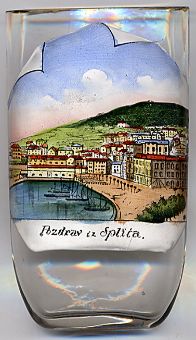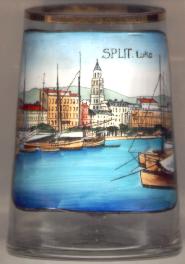

|
| HRVATSKA | CROATIA |
| županija: Splitsko-dalmatinska |
 Split is Croatia's second biggest city after Zagreb and the
economical and cultural centre of Dalmatia. The region was already
inhabited in prehistoric times. During the last centuries BC, Illyrian
tribes came into the area, followed shortly afterwards by the Greek. The
Greek called the area Aspalatos. Roman settlements originated
after 78 BC, but only from the 3rd century onwards the place (Spalatum) gained
importance when the Roman emperor Diocletianus in 295 AD began to build a
large palace in the country of his birth. The palace measured 215 m in length
and 180 in width. From 305, the year of his abdication, Diocletianus
spent the remainig years of his life here. Its outer walls and many palace
buildings are still visible today. During the Migrations Period with the invasions of Avars and Slavs in the 7th century
inhabitants of the Dalmatian islands fled and founded a new settlement within
the walls of the palace. Until the 10th century the medieval town remained inside
these walls. From the 10th and 11th century the town
was relatively autonomous even when it became part of the Croatian-Hungarian kingdom.
The economical prosperity was limited when the Republic of Venice came into
possession of Split in 1420. Between 1797 and 1918 Split was part of the
Austrian Monarchy, only interrupted by the time of the Napoleonic rule 1805–1813
The old town of Split with the Palace of Diocletian was listed as a UNESCO World Heritage site in 1979.
(see also list of other UNESCO heritage sites depicted on glasses of this collection)
Split is Croatia's second biggest city after Zagreb and the
economical and cultural centre of Dalmatia. The region was already
inhabited in prehistoric times. During the last centuries BC, Illyrian
tribes came into the area, followed shortly afterwards by the Greek. The
Greek called the area Aspalatos. Roman settlements originated
after 78 BC, but only from the 3rd century onwards the place (Spalatum) gained
importance when the Roman emperor Diocletianus in 295 AD began to build a
large palace in the country of his birth. The palace measured 215 m in length
and 180 in width. From 305, the year of his abdication, Diocletianus
spent the remainig years of his life here. Its outer walls and many palace
buildings are still visible today. During the Migrations Period with the invasions of Avars and Slavs in the 7th century
inhabitants of the Dalmatian islands fled and founded a new settlement within
the walls of the palace. Until the 10th century the medieval town remained inside
these walls. From the 10th and 11th century the town
was relatively autonomous even when it became part of the Croatian-Hungarian kingdom.
The economical prosperity was limited when the Republic of Venice came into
possession of Split in 1420. Between 1797 and 1918 Split was part of the
Austrian Monarchy, only interrupted by the time of the Napoleonic rule 1805–1813
The old town of Split with the Palace of Diocletian was listed as a UNESCO World Heritage site in 1979.
(see also list of other UNESCO heritage sites depicted on glasses of this collection)

The old town is dominated by the
 Campanile [left],
the bell-tower of the cathedral of St. Domnius. The campanile was built
between the 13th and 16th century and thus contains characteristics of
Romanesque, Gothic, and Renaissance styles. The cathedral itself is the
original mausoleum of Emperor Diocletianus of the 4th century. It was converted
to a christian church in the 7th century by the papal legate Johannes of Ravenna.
Campanile [left],
the bell-tower of the cathedral of St. Domnius. The campanile was built
between the 13th and 16th century and thus contains characteristics of
Romanesque, Gothic, and Renaissance styles. The cathedral itself is the
original mausoleum of Emperor Diocletianus of the 4th century. It was converted
to a christian church in the 7th century by the papal legate Johannes of Ravenna.
Split is the birth place of the famous Austrian operetta composer Franz von SUPPÉ (1819–1895;
real name Francesco Ezechiele Ermenegildo de Suppè).
![[scale]](lineal.jpg)